Have you ever purchased beautiful, colorful succulents, only to have them turn mostly green in a short period of time? Or have you seen your succulents changing color and wondered why? This post is for you! The short answer is stress. Stressed succulents frequently flush brilliant colors in response to more sunlight, less water or a change in temperature. Now tell me – are you interested in soothing succulent stress? Or do you want to learn how to cause it? 🙂 Don’t worry — I won’t judge! Let’s take a closer look at what causes more colorful succulents.
Succulents Changing Color Due to Stress
In this Post We'll Cover:
{Please note, some links in this post may be affiliate links to sites that pay me a small commission if you click on the link and make a purchase. This commission is at absolutely no cost to you. I only recommend products and companies that I have worked with and truly love! ~Kat}
What is Succulent Stress?
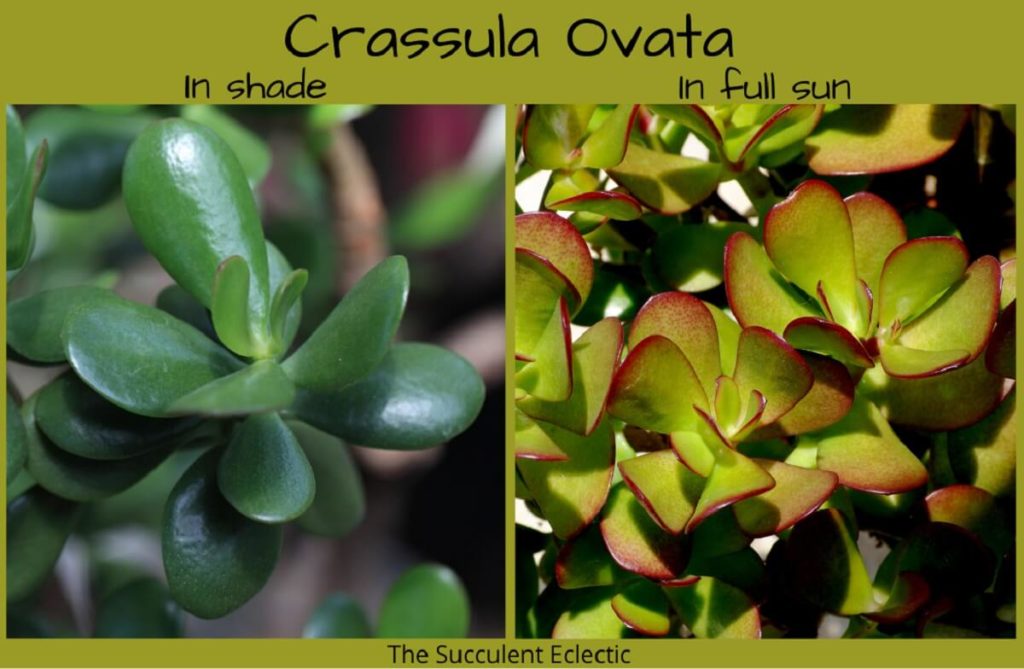
Stress comes in many forms. It is a simple fact of life, for our plants as well as for us. We tend to do a great deal to limit our stress, and to protect those we love from it. But this is based on a very limited notion of “stress”. Yes, sometimes stress can be very damaging. But some stress, in limited doses, can actually make us stronger, and more fit. We now know that exposing very young children to germs actually results in them developing a more robust immune system. But it is also exposing them to stress. When they play in the dirt, their immune system is stressed by encountering microbes. The strengthening of the immune system in response to this is just like muscles building strength in response to exercise — which is another form of physical stress.
Plant stress can be seen as any deviation from optimal growing conditions that requires a physical response from the plant. When plants grow very tall in low light, that etiolation is a response to stress. This is an example of damaging stress. When a plant is grown in sufficient sunlight, it retains a more compact growth habit. If the same plant gets even more sunlight, it often develops more intense coloring, like the crassula ovata above. This is due to the plant’s production of anthocyaninAnthocyanin (An-tho-SY-an-in) is a blue, red or violet pigme... and carotenoidCarotenoid (Kair-AH-ten-oid) is a yellow, red or orange fat-... to combat the stress of excess sun exposure.
Anthocyanin and Carotenoid
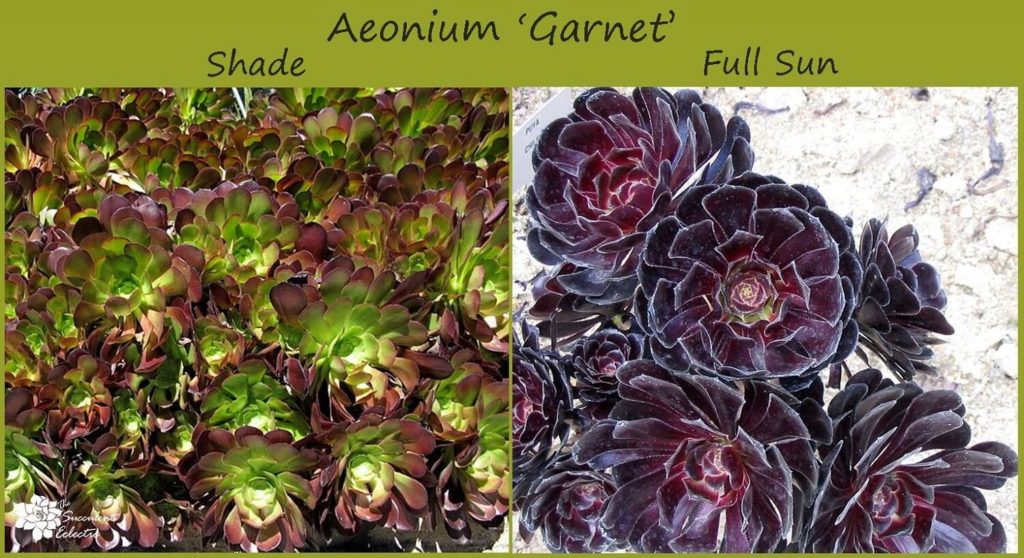
Anthocyanin and carotenoid are pigments in plant tissue that protect the plant from a range of environmental stresses. Anthocyanin is typically a blue, violet or red, while carotenoid are generally yellow, orange and red in color. When a plant senses an environmental stress, like an increase in sun exposure, it produces more anthocyanin and carotenoid to protect itself. In this way, these antioxidant pigments are similar to melanin, the brownish-black pigment in the skin of people and animals. Anthocyanin, carotenoid and melanin all protect against damage due to UV radiation from sun exposure. When we spend time in the sun – a form of stress – we tan, or become more brown, as our bodies increase their production of melanin. So, too, do plants produce more pigments in response to an array of stresses, including increased sun exposure. The more anthocyanin and carotenoid a plant produces, the more intensely colored it becomes. When they experience stress, we see more colorful succulents.
Most Common Forms of Colorful Succulent Stress
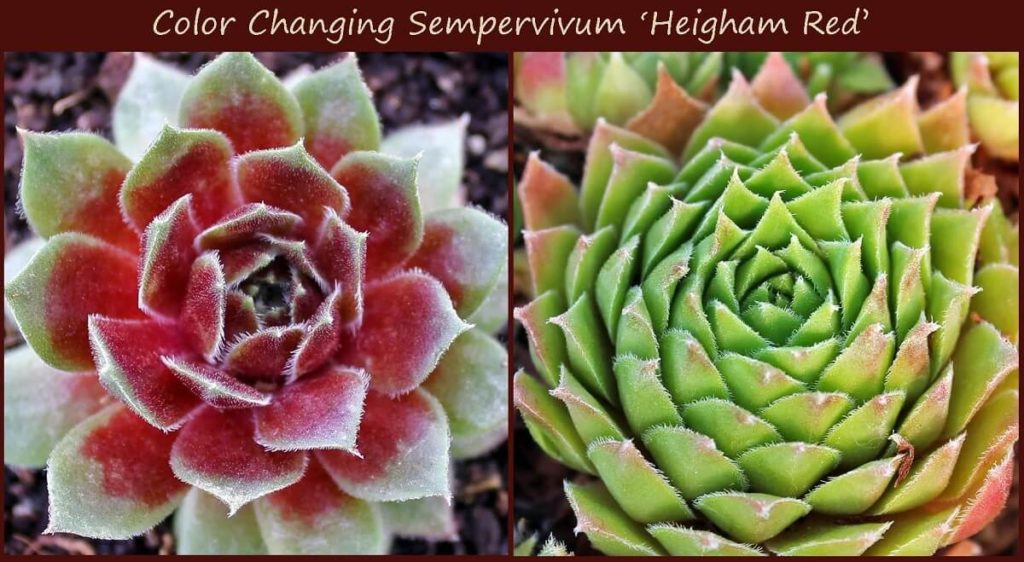
Many environmental changes can cause succulent stress. Predation by insects and herbivores, trampling by kids, etc. We’re focusing on the types of stress that cause succulents to increase their production of anthocyanin or caretenoid. For this, there are 3 types of stress that are the most common causes of succulents changing color:
- Changes in sun exposure
- Temperature fluctuations and seasonal changes
- Changes in water levels in the soil
Each of these types of succulent stress will cause a plant to change its production of anthocyanin. When a plant is getting more sunlight, it will increase its production of anthocyanin, in order to combat potential damage due to UV rays. The colorful flavonoid also provides protection from dropping temperatures. And, when water is especially scarce, this, too, will cause a succulent to increase its production of anthocyanin.
The images of Sempervivum ‘Heighman Red’ were provided by Mountain Crest Gardens.
Changes in Sun Exposure & Stressed Succulents
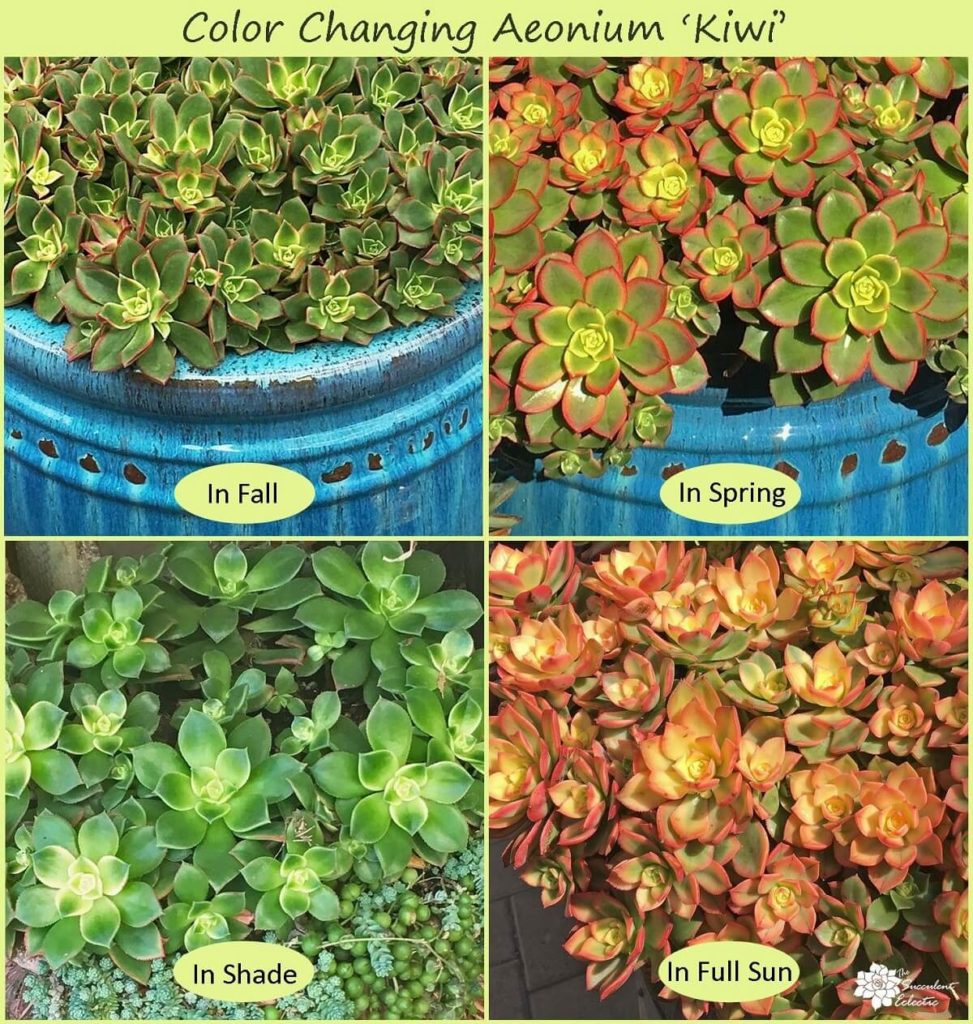
As we have discussed, anthocyanin in plants is similar to melanin in animals and people, and it acts in much the same ways. When you play in the sun and develop a tan, your skin produces melanin in greater quantities, giving you a browner color. The melanin protects you from damaging UV rays. So, too, do plants develop more colorfully pigmented anthocyanin in response to sun exposure. The pigment protects the plant’s leaves from damage due to the sun’s rays and UV radiation. Increased sun exposure causes the stressed succulents to produce more anthocyanin for protection. The color changes can be quite remarkable.
At the Succulent Cafe, one of my favorite haunts, they grow a lot of aeonium kiwi. I took the photo on the top left last October. This April, I returned to take the other 3 photos. The same plant in the same blue pot shows far more color in the spring due to more hours of daylight. As the plant receives more sunlight, it produces more anthocyanin, resulting in vibrant yellow and red margins to the leaves. Another kiwi was growing in a lot of shade, demonstrating a far softer coloration altogether in an absence of the flavonoid. A third plant was in full sun all day long, and it has developed the most protective pigmentation.
All of these plants are healthy and happy. The plant shown in the top 2 photos is actually grown in the correct amount of sun exposure. Changes in the season caused enough change in the amount of sunshine to result in an increase in anthocyanin and carotenoid production in the spring months. Or, put another way — the sun exposure stress led to more colorful succulents.
Seasons, Temperatures and Succulents Changing Color
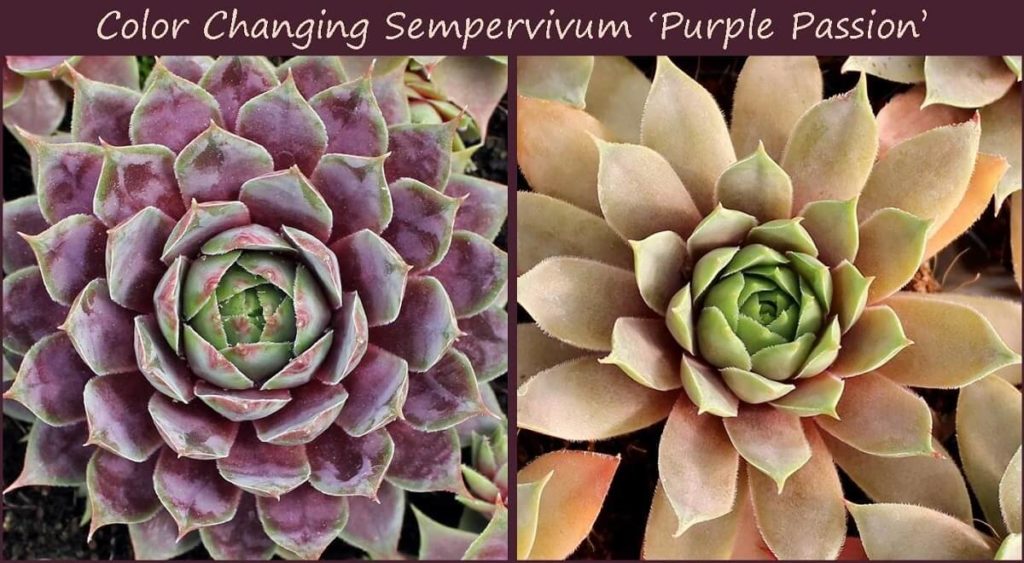
When the seasons change, plants experience temperature differences in addition to lighting changes. For the cold hardy sempervivum ‘Purple Passion’, the seasonal fluctuations cause the rosettes to dramatically change color as well as shape. Because both sunshine and heat are more plentiful in the spring, the rosette flushes with purple anthocyanin for protection, as shown on the left. The rosette remains a bit more closed, with each leaf partially shading the next.
In the cooler temps and lower light of fall and winter, the Sempervivum opens up wide, exposing each leaf to much more light, to maximize photosynthesisPhotosynthesis (FO-to-SIN-thuh-sis) is the process plants us... More. Because the threat of UV ray damage is lessened, the protective pigment is reduced as well, resulting in a far different color. What could easily be mistaken for two very different, colorful succulents, is actually the same plant growing in very different conditions brought on by the change in seasons.
My thanks to Mountain Crest Gardens for the use of their Sempervivum Purple Passion photos!
Water Stressed Succulents Changing Color
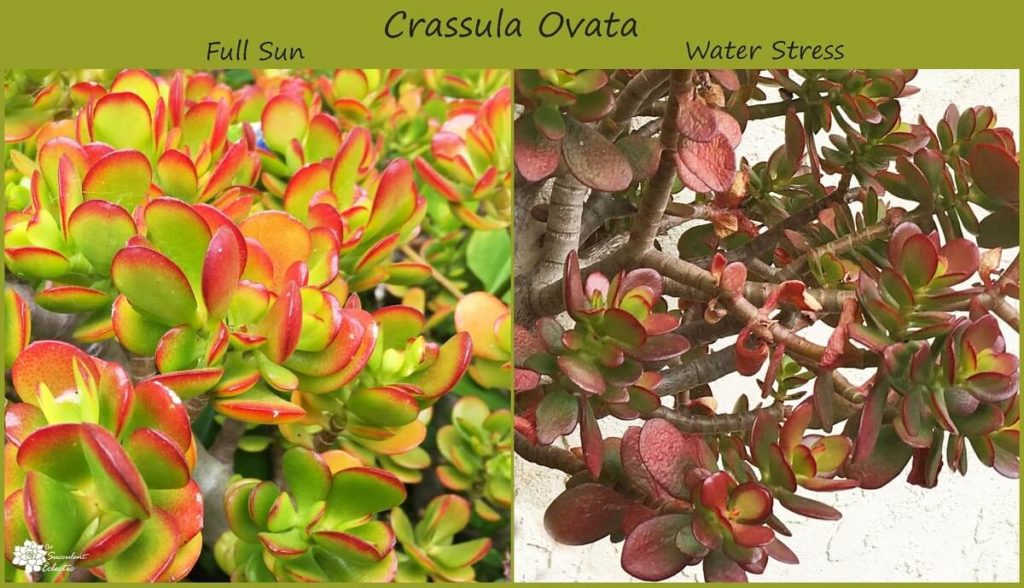
The third common cause of stressed succulents changing color is water stress. Succulent plants are extraordinarily well adapted to growing where water is scarce. Their water storage capabilities are what make them succulents, after all. Typically, their natural environment stays dry for long periods, punctuated by short bursts of rainfall. This drought and drench cycle is a natural condition for them, and no cause of stress. If the period of dry soil is extensive, however, and the amount of water they receive at the “drench” time is unusually limited over an extended period of time, the plants do become stressed. In response, they produce higher levels of anthocyanin.
Above, you see photos of two green jade plants I have growing in my garden. The one on the left developed bright scarlet margins because it is grown in full sun. I have been experimenting with water stressing the one on the right for a couple of years. While it is grown in more shade than the one on the left, it has also developed considerably more red pigment, to combat the stress of the very low water levels it receives.
Succulent Stress and Good Health
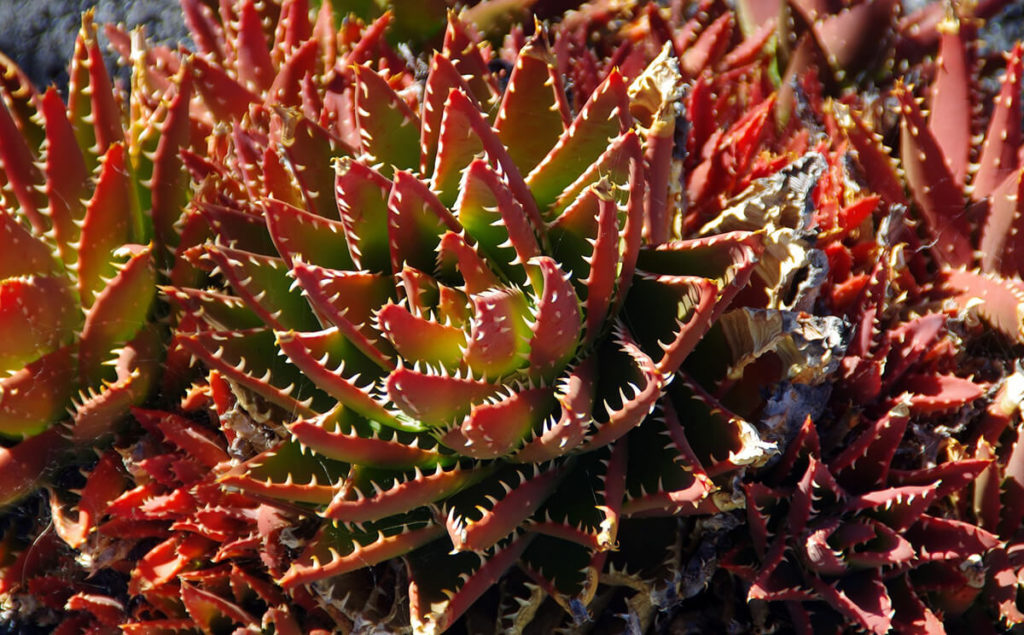
Understanding the causes behind succulents changing color will help you to take better care of them. But don’t let your love of the plants misguide you into trying to spare them from any and all forms of stress. Change, and the resulting stress, is a part of their natural world. Protecting them from nature can inhibit their ability to truly thrive. All forms of life encounter and respond to stress. So long as the stress is not crippling, and the response does not compromise its health, a life form that experiences and responds to stress becomes more healthy and more fit to survive.
Now let’s see exactly how to stress succulents to bring out their vivid coloring. And most importantly – how to do so without harming them!
Enjoy your colorful succulents! If you have any questions, please let me know. I am here to help!

P.S. For more information on succulent care, crafts and design, please subscribe! I’ll send you my FREE e-course, 7 Steps to Succulent Success! Thanks!
P.P.S. Why not join my Facebook Group for succulent lovers? We talk about succulent care, propagation, succulent identification, and design. It’s a warm and welcoming group that would love to meet you!
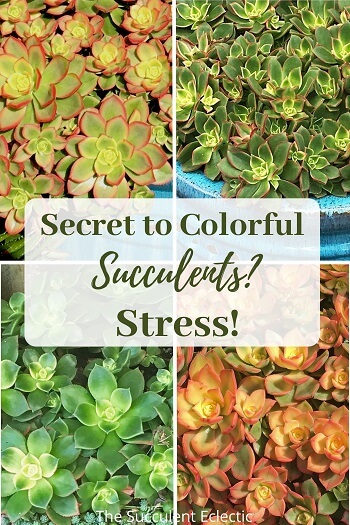
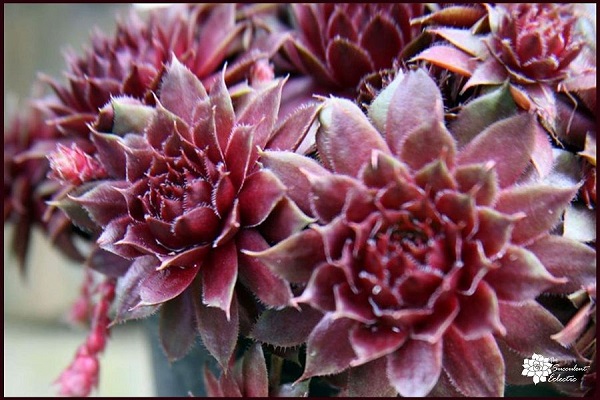

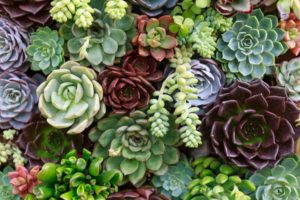
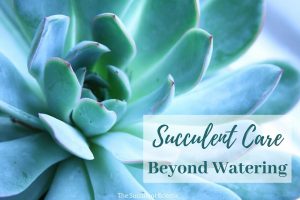
if a succulent is turning brown does that mean it’s getting too much sunlight.
Hi Leona,
Depending upon the succulent, the brown may be stress coloring due to heat, sun exposure, cold, or low water, or it may be a sign of sunburn. To give you a definitive answer, I would need to see a photo. If you can send me a picture, please send it to kat [at] thesucculenteclectic [dot] com.
Thanks so much!
~Kat